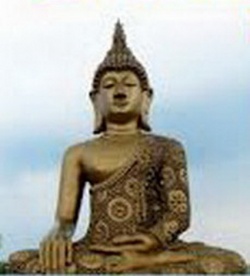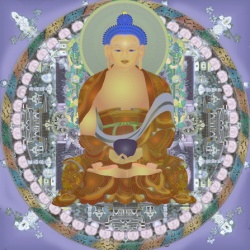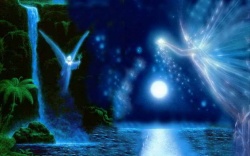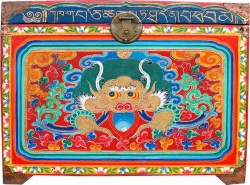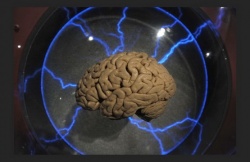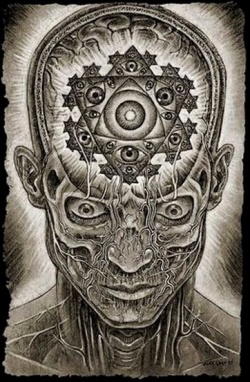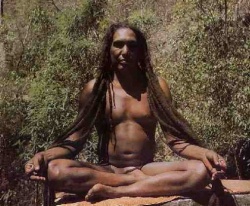Khandha
- See also:Skandha
khandha: the 5 'groups (of existence)' or 'groups of clinging' (upādānakkhandha); alternative renderings: Aggregates, categories of clinging's objects.
These are the 5 aspects in which The Buddha has summed up all the physical and Mental Phenomena of existence, and which appear to the ignorant man as his ego, or personality, to wit:
(1) the Corporeality Group (Rūpa-Kkhandha),
(2) the Feeling Group (vedanā-Kkhandha),
(3) the Perception Group (saññā-Kkhandha),
(4) the Mental-formation group (Sankhāra-Kkhandha),
(5) the Consciousness-group (Viññāna-Kkhandha).
"Whatever there exists of corporeal things, whether past, present or future, one's own or external, gross or subtle, lofty or low, far or near, all that belongs to the Corporeality Group. Whatever there exists of Feeling ... of Perception ... of Mental formations ... of Consciousness ... all that belongs to the Consciousness-group" (S. XXII, 48). -
Another division is that into the 2 groups:
Mind (2-5) and
corporeality ( (Nāma-Rūpa),
whilst in Dhamma Sanganī, the first book of the Abhidhamma, all the Phenomena are treated by way of 3 groups:
Consciousness (5),
Mental factors (2-4),
corporeality , in Pāli Citta, Cetasika, Rūpa. Cf. Guide I.
What is called individual existence is in reality nothing but a mere process of those Mental and physical Phenomena, a process that since time immemorial has been going on, and that also after Death will still continue for unthinkably long periods of time. These 5 groups, however, neither singly nor collectively constitute any self-dependent real ego-entity, or personality (attā), nor is there to be found any such entity apart from them. Hence the belief in such an ego-entity or personality, as real in the ultimate sense, proves a mere Illusion.
"When all constituent parts are there,
The designation 'cart' is used;
Just so, where the five groups exist,
Of 'living being' do we speak." (S. V. 10).
The fact ought to be emphasized here that these 5 groups, correctly speaking, merely Form an abstract classification by The Buddha, but that they as such, i.e. as just these 5 complete groups, have no real existence, since only single representatives of these groups, mostly variable, can arise with any state of Consciousness. For example, with one and the same unit of Consciousness only one single kind of Feeling, say Joy or sorrow, can be associated and never more than one. Similarly, two different perceptions cannot arise at the same moment. Also, of the various kinds of sense-cognition or Consciousness, only one can be present at a time, for example, seeing, hearing or inner Consciousness, etc. Of the 50 Mental formations, however, a smaller or larger number are always associated with every state of Consciousness, as we shall see later on.
Some writers on Buddhism who have not understood that the five khandha are just classificatory groupings, have conceived them as compact entities ('heaps', 'bundles'), while actually, as stated above, the groups never exist as such, i.e. they never occur in a simultaneous totality of all their constituents. Also those single constituents of a group which are present in any given Body- and -Mind process, are of an evanescent nature, and so also their varying combinations. Feeling, Perception and Mental formations are only different aspects and functions of a single unit of Consciousness. They are to Consciousness what redness, softness, sweetness, etc. are to an apple and have as little separate existence as those qualities.
In S. XXII, 56, there is the following short definition of these 5 groups:
"What, o Monks, is the corporeality-group? The 4 primary elements (mahā-bhūta or Dhātu) and corporeality depending thereon, this is called the corporeality-group.
"What, o Monks, is the Feeling-group? There are 6 classes of Feeling: due to visual impression, to Sound impression, to odour impression, to taste impression, to bodily impression, and to Mind impression....
"What, o Monks, is the Perception-group? There are 6 classes of Perception: Perception of visual objects, of sounds, of odours, of tastes, of bodily impressions, and of Mental impressions....
"What, o Monks, is the Group of Mental Formations? There are 6 classes of volitional states (cetanā): with regard to visual objects, to sounds, to odours, to tastes, to bodily impressions and to Mind objects....
"What, o Monks, is the Consciousness-group? There are 6 classes of Consciousness: eye-Consciousness, ear-Consciousness, nose-Consciousness, tongue-Consciousness, Body-Consciousness, and Mind-Consciousness."
About the inseparability of the groups it is said:
Whatever, o brother, there exists of Feeling, of Perception and of Mental formations, these things are associated, not dissociated, and it is impossible to separate one from the other and show their difference. For whatever one feels, one perceives; and whatever one perceives, of this one is conscious" (M. 43).
Further: "Impossible is it for anyone to explain the passing out of one existence and the entering into a new existence, or the growth, increase and development of Consciousness independent of corporeality, Feeling, Perception and Mental formations" (S. XII, 53)
For the inseparability and mutual conditionality of the 4 Mental groups s. Paccaya (6, 7).
Regarding the impersonality (anattā) and Emptiness (suññatā) of the 5 groups, it is said in S. XXII, 49:
"Whatever there is of corporeality, Feeling, Perception, [[Mental formations and Consciousness, whether past, present or future, one's own or external, gross or subtle, lofty or low, far or near, this one should understand according to reality and true Wisdom: 'This does not belong to me, this am I not, this is not my Ego.' "
Further in S. XXII, 95: "Suppose that a man who is not blind were to behold the many bubbles on the Ganges as they are driving along; and he should watch them and carefully examine them. After carefully examining them, however, they will appear to him empty, unreal and unsubstantial. In exactly the same way does the Monk behold all the corporeal Phenomena ... feelings ... perceptions ... Mental formations ... states of Consciousness, whether they be of the past, present or future ... far or near. And he watches them and examines them carefully; and after carefully examining them, they appear to him empty, unreal and unsubstantial."
The 5 groups are compared, respectively, to a lump of froth, a bubble, a mirage, a coreless plantain stem, and a conjuring trick (S. XXII, 95).
See the Khandha Samyutta (S. XXII); Vis.M. XIV.
SUMMARY OF THE 5 GROUPS
I. Corporeality Group (Rūpa-Kkhandha)
A. Underived (no-upādā): 4 elements
the solid, or earth-element (pathavī-Dhātu)
the liquid, or water-element (āpo-Dhātu)
heat, or Fire-element (tejo-Dhātu)
motion, or wind-element (vāyo-Dhātu)
B. Derived (upādā): 24 secondary Phenomena
Physical sense-organs of: seeing, hearing, smelling, tasting, Body
Physical sense-objects: Form, Sound, odour, taste, (bodily impacts)
'Bodily impacts' (photthabba) are generally omitted in this list, because these physical objects of Body-sensitivity are identical with the afore-mentioned solid element, heat and motion element. Hence their inclusion under 'derived corporeality' would be a duplication.
femininity (itthindriya)
virility (purisindriya)
physical base of Mind (hadaya-vatthu)
bodily expression (Kāya-viññatti; s. viññatti)
verbal expression (vacī-viññatti)
physical Life (Rūpa jīvita; s. jīvita)
space element (ākāsa-Dhātu)
physical agility (rūpassa lahutā)
physical elasticity (rūpassa mudutā)
physical adaptability (rūpassa Kammaññatā)
physical growth (rūpassa upacaya)
physical continuity (rūpassa santati; s. santāna)
decay (jarā)
Impermanence (aniccatā)
nutriment (āhāra)
II. Feeling Group (vedanā-Kkhandha)
All feelings may, according to their nature, be classified as 5 kinds:
bodily agreeable Feeling Sukha = kāyikā sukhā vedanā
bodily painful Feeling Dukkha = kāyikā dukkhā vedanā
mentally agreeable Feeling somanassa = cetasikā sukhā vedanā
mentally painful Feeling domanassa = cetasikā dukkhā vedanā
indifferent Feeling upekkhā = adukkha-m-asukhā vedanā
III. Perception Group (saññā-Kkhandha)
All perceptions are divided into 6 classes:
Perception of Form, Sound, odour, taste, bodily impression, and Mental impression.
IV. Group of Mental Formations (Sankhāra-Kkhandha)
This group comprises 50 Mental Phenomena, of which
11 are general psychological elements,
25 lofty (sobhana) qualities,
14 karmically unwholesome qualities. Cf. Tab. II.
V. Consciousness Group (Viññāna-Kkhandha)
The Suttas divide Consciousness, according to the senses, into 6 classes:
eye-, ear-, nose-, tongue-, Body-, Mind-Consciousness.
The Abhidhamma and commentaries, however, distinguish, from the karmical or Moral viewpoint,
89 classes of Consciousness. Cf. Viññāna and Tab. 1.
The Moral quality of Feeling, Perception and Consciousness is determined by the Mental formations.
